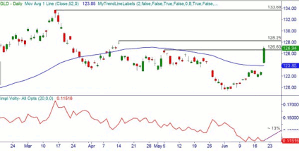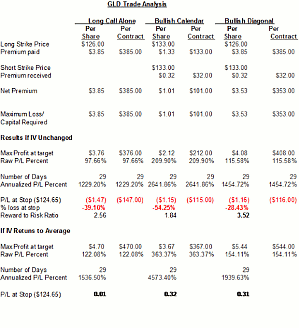In this article, options expert Russ Allen of Online Trading Academy discusses options positions, specifically, how diagonal spreads can offer both the upside of the long call and the cost reduction contribution of the short call.
I’ve recently been writing about option positions that include both anchors (the option intended to provide the profit) and offsets (the option used to reduce some undesirable features of the anchor alone). We’ll look at another example today.
In last week’s article, we looked at an example using the gold ETF (GLD). This is what its chart looked like at that time:
We compared a long call with a Bullish Calendar.
The long call was slightly in the money—we used the September 126, which could be bought for $3.85. We thought that with IV still pretty low, and calls therefore pretty cheap, this would be a good choice.
We also considered a bullish calendar, using a $133 target price (recent swing high) as the strike. We used the September expiration for the anchor, and the July expiration for the offset.
Below is the table that compared these two positions:
The calendar position had some clear advantages—it cost less ($1.01 per share compared to $3.85) and had a higher profit percentage at the $133 target (363% versus 122% for the call alone).
Was there any disadvantage to the calendar? There was one: the calendar, being at a higher strike, would lose a higher percentage of its investment if GLD dropped. We contemplated setting a stop for both positions at the low of the recent big up move, at $124.65. If GLD should drop that far, we would plan to exit either position. The P/L at that point can be projected only using option payoff graphing software, which is included in all good option trading platforms.
In the case, where GLD dropped to the $124.65 stop by the July expiration, the 126 call by itself would lose about $1.47, or 39% of its $3.85 cost. The calendar, meanwhile, would lose about $1.15, or 54% of its cost. This was a pretty big difference.
Was there an alternative that would cost less on the downside? Would I ask the question if not?
Here is another possibility. Instead of the calendar, let’s look at a diagonal spread. This is a combination of the in-the-money September 126 option from the long call position, together with the out-of-the-money 133 short option from the calendar spread. This gives both the upside of the long call and the cost reduction contribution of the short call. With the anchor being in the money, the percentage loss is also reduced. Adding this alternative to the table, we now have this comparison:
With a stop figured in, we can now calculate and compare the ratio of reward (max profit at target) to risk (amount of loss at the stop, red figures).
Note that the Diagonal has a loss at the stop of 28%, much better than either the call alone (39%) or the calendar (54%).
The Diagonal also has a much better reward-to-risk ratio, at 3.52, than either the call (at 2.56) or the calendar (at 1.84).
If Implied Volatility returns to its average level, the Diagonal would benefit a great deal; more so than the call alone, although its gains in that case would not be as spectacular as the Calendar. Both the Diagonal and the Calendar would have a significant profit of about $.30 per share if IV did increase, even if GLD were to drop to the stop price. The call alone would just break even in that case.
All things considered, the Diagonal looks like the winner of this shootout. With knowledge of what types of strategies are likely to work best when we are bullish on both price and volatility, we were able to determine what strategies to consider. We could then compare alternatives and select the best tool for the job. And that’s what option trading is all about.
By Russ Allen, Instructor, Online Trading Academy













